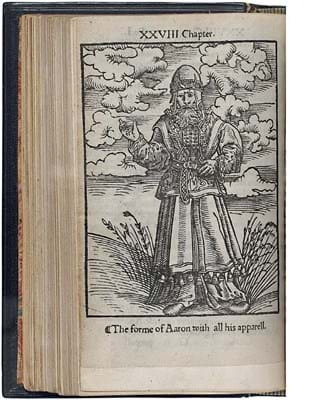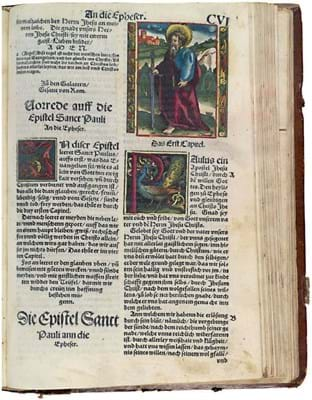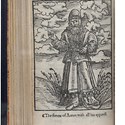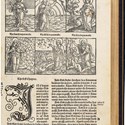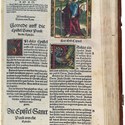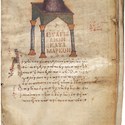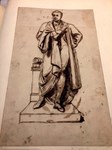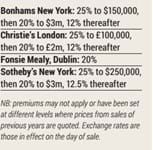Books and works on paper
A TRULY magnificent bible collection formed by the late Dr Charles Caldwell Ryrie (1925-2016), theologian, scholar and compiler of the best-selling Ryrie Study Bible, sold for a premium-inclusive $7.34m (£5.78m) at Sotheby’s New York.
Only 15 of the 195 lots failed to find new homes, 13 achieved prices in excess of $100,000, including premiums, and close on 60% of lots sold over estimate.
Top lot in this December 5 sale, at $1.4m (£1.1m) sold to an American collector, was a vellum manuscript copy of John Wycliffe’s Middle English New Testament dating from the first half of the 15th century. That important lot was illustrated and described in some detail in a preview published in ATG No 2269, along with a copy of John Eliot’s 1660s ‘Indian Bible’ that sold at $220,000 (£173,800).
Last week’s Antiquarian Books pages (ATG No 2273) included a note and illustration of a defective and incomplete manuscript of the Gospel of Luke and John in Greek that sold for $140,000 (£110,235) to an American collector.
A number of other Ryrie highlights are described here.
Manuscripts
Other notable manuscript successes included, at a much higher than predicted $220,000 (£173,800), a Greek text vellum manuscript of the Four Gospels with commentary that was produced in 11th century Constantinople.
Two Greek monks who sold it to New York dealer Joseph Martini in 1913 said it came from the Monastery of Great Lavra on Mount Athos.
It was last seen at auction in 1980, when it sold for $11,000 at Christie’s New York.
A second, even earlier Greek text Gospel manuscript of Constantinople origin, this time written in the early to mid-10th century, was sold for $200,000 (£158,100) – again a notably higher than expected sum.
This incomplete vellum manuscript runs to 270 leaves but lacks at least 100 more from the opening section, including nearly all of Matthew and the opening parts of Luke and John. It is known as the ‘Benton Gospels’ after the Rev George Benton (d.1862), an American Episcopal missionary in Greece who had bought it in Crete.
In 1913 it was presented by one of his grandchildren to the General Theological Seminary in New York, who sold it at Christie’s in 1980 for $9500. An illuminated page from the manuscript, now disbound in severely worm-eaten vellum, is shown on the facing page.
Printed works
Inevitably, the collection included a leaf from the 42-line Gutenberg Bible – in fact, two of them.
They were both examples of those Noble Fragments that resulted from New York dealer Gabriel Wells’ decision to break up and sell – along with an essay by A Edward Newton – single leaves and, in some instances, groups of leaves, from the ex-Munich Royal Library/Robert Curzon paper copy that he bought at Sotheby’s in 1920. They sold for $38,000 (£30,020) each this time around.
Bid to $90,000 (£71,100) was a partial leaf (illustrated above) from a vellum copy of the much rarer 36-line Bible, printed not later than 1461 at Bamberg by Albrecht Pfister.
It used earlier and larger types that date to the early 1450s and which he presumably bought from Gutenberg.
As with the earlier Gutenberg Bible, the 36-line Bible was issued in both paper and vellum copies. However, whereas 14 paper copies survive (some incomplete), all vellum copies were disposed of in the 16th-17th centuries and are known only by their chance survival as binding waste.
The leaf in the Ryrie collection (shown above) is from a copy that was dismembered to provide document wrappers by the Jesuit College of Munich in the early 17th century. A dozen or more leaves from this copy are at the Bayerische Staatsbibliothek, and others can now be found in the Scheide Library at Princeton, the Bridwell and Newberry Libraries and the Library of Congress.
A 1530 printing of The First Boke of Moses called Genesis that marks the first appearance of any portion of the Old Testament to be printed in English sold at $550,000 (£434,500) to an English dealer.
The colophon of this octavo volume says that it was “emprented at Malborow in the lande of Hesse, by me Hans Luft… ”, but it was in fact printed by Johan Hoochstraten of Antwerp, and the translation, of course, was the work of William Tyndale. His command of the original Hebrew may not have been perfect, but here he provided the basis of all subsequent English versions.
In a 19th century English binding of blue morocco, it has the first nine leaves and three divisional titles in facsimile and 36 leaves that have been remarginned have facsimile shoulder notes. A few other leaves may have been supplied from another copy, but of the eight copies recorded, this is the only one still in private hands and, though making its third appearance at Sotheby’s, is the only one to have come to auction in more than a century.
Its last outing was in 1976 when it was sold to benefit the Contemporary Dance Trust and on that occasion it was the English dealer Alan G Thomas who successfully bid for it on Dr Ryrie’s behalf.
In 2013, in the same rooms, a 1534 second edition of this translation, Tyndale’s Pentateuch, sold for $250,000.
The first edition of the whole bible in English was Miles Coverdale’s woodcut illustrated version of 1535- 36. With only 10 leaves supplied in facsimile, the Ryrie copy was one of the more complete examples offered at auction in a couple of decades. It sold at $280,000 (£221,200).
Once understood to have been printed in Zurich, it is now thought more likely to have been produced by Eucherius Cervicornus and Johannes Sloter in Cologne.
Also published in 1535 was the second (first Augsburg) edition of Martin Luther’s complete German Bible, printed by Heynrich Steyner. The copy in the Ryrie collection was a superb example. One of only 11 surviving examples printed on vellum, it has all the woodcut illustrations and most of the historiated and other decorated initials in full contemporary colour.
In a 17th century binding of brown calf gilt, it sold at a triple-estimate $260,000 (£205,400).
Sold for $320,000 (£252,800) to an American collector was an exceptional copy of the 1611, first edition of the King James Bible… that once belonged to to Sir George Moore, a close confidant of King James and a member of his royal household.
In a fine contemporary London binding of blind tooled calf and the tallest copy known, it was once part of the library of Louis Silver (1902-63), a Chicago bibliophile who sold his entire collection to the local Newbery Library. In 1965 it re-emerged at Sotheby’s London, where it was acquired for Dr Ryrie by the leading US dealer John Fleming, who called it a bargain at £5500.
Other Ryrie sale highlights include a 1769 edition of the Oxford ‘Standard’ Bible in period speckled calf. This edition is known only from copies now in the British Library, the John Ryland Library in Manchester and Pembroke College, Oxford – a fire at the printer’s warehouse having destroyed much of the run. Estimated at $6000-8000, it sold at $40,000 (£31,600).
Among the varied items that brought the sale to a close was a 1543 Certificate of Ordination signed by Martin Luther, which sold at $60,000 (£47,400). Appointing a local teacher, Heinrich Kichtenburg, to the parsonage of Wolfsbehringen, Wittenberg, it is printed on both sides of a single leaf. The certificate is countersignd by Johann Bugenhagen and accomplished by Philip Melanchthon.
Although 740 ordinations were performed, only around 20 Latin certificates, all of them manuscript, are known. Of the German language certificates, only one manuscript and half-a-dozen printed examples are recorded.



